Featured Comment:
“I’ve been making these dangos since I first discovered the recipe in 2021 and it’s my go-to recipe! the texture is perfect and they’re so tasty~ thanks 🍡🍡”
– @rose_shimmerling (from YouTube)
Disclaimer: This post may contain Amazon affiliate links. Sudachi earns a small percentage from qualifying purchases at no extra cost to you. See disclaimer for more info.
What is Hanami Dango?
Dango are a type of sweet Japanese rice dumpling commonly served on a skewer. They are traditionally made from rice flour and water, and sometimes sweetened with sugar. Most dango are subtly sweet with a simple rice flavor and are well-loved for their wonderful “mochi mochi” chewy texture.
One of the most famous variations of dango is the “Hanami Dango” (花見団子) which is known for its vibrant colors of pink, white, and green. The name “hanami” means “cherry blossom viewing” and comes from the time of year in which it is most associated. However, as one of Japan’s most loved sweets and you can find Hanami Dango in supermarkets and convenience stores across Japan all year around.
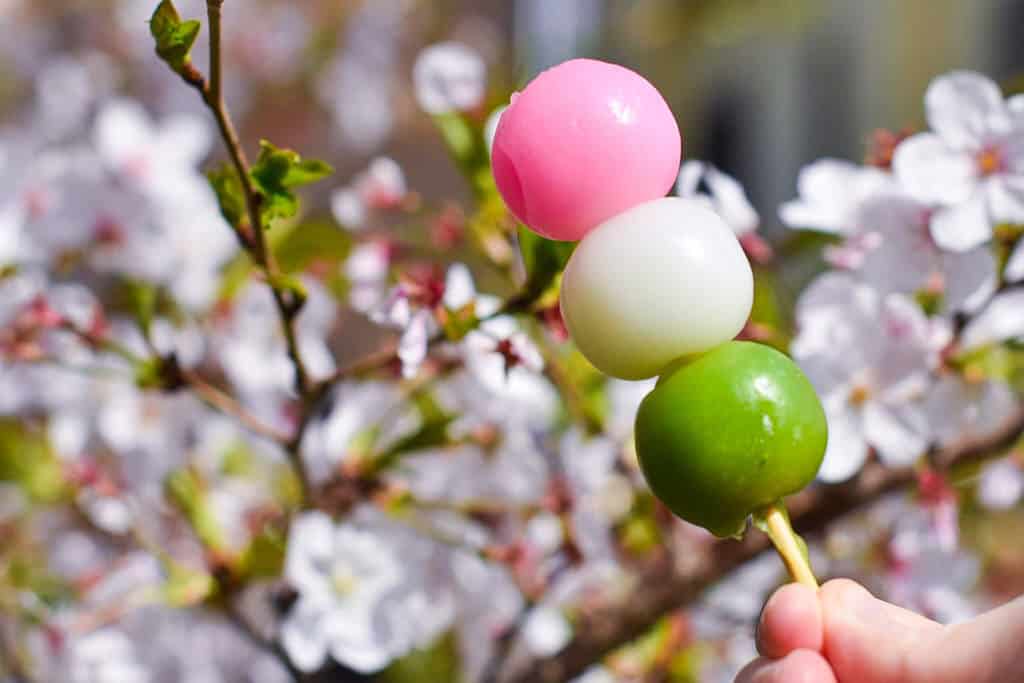
Other Kinds of Dango
There are many different kinds of dango and some of them are eaten at special times of the year. Here are a few of the most popular dango varieties.
- Mitarashi Dango (みたらし団子) Simple plain rice dumplings that have been lightly charred and coated in a sweet soy glaze, then served on a skewer.
- Hanami Dango (花見団子) Sweetened tri-colored rice dumplings (pink, white and green) served on a skewer and associated with cherry blossom viewing and spring.
- Anko Dango (餡子団子) Rice dumplings served on a skewer and coated with red bean paste.
- Goma Dango (ごま団子) Chinese style deep fried rice dumpling covered in sesame seeds and filled with red bean paste.
- Shiratama Dango (白玉団子) Small rice dumplings usually served in desserts such as anmitsu (traditional dessert made of agar agar jelly, red bean and fruits) or kakigori (shaved ice).
- Tsukimi Dango (月見団子) A pyramid of 15 rice dumplings displayed during the Autumn full moon.
Outside of the cherry blossom season, hanami dango is sometimes known as “sanshoku dango” (三色団子) however, this simply means “tri-colored” dango and could technically be any three colors. One other example of a tri-colored dango is the green, white, and yellow sanshoku dango that appears around the moon gazing season (tsukimi) in September and October.

The Meaning Behind Hanami Dango’s Colors
Many people believe that the colors of Hanami Dango represent the seasons in some way and various theories are circling this idea.
Some say that the pink dango represents cherry blossoms blooming in spring, white is winter’s snow and green is the summer leaves. If you’re wondering why Autumn is missing, there’s a supposed reason for that too.
In Japanese, the phrase “akinai” (飽きない) means to never get bored of something. As a play on words, this sounds similar to “aki ga nai” (no autumn). In other words, there is no autumn because you never get bored of Hanami Dango!
Another theory says that Hanami Dango represents spring alone. Again, pink is the cherry blossoms, white is the “shirozake” (white sake) often served during “Hinamatsuri” (girl’s day in March) and green is the Japanese mugwort called “yomogi” that grows in spring.
The final theory claims that each color represents each stage of the cherry blossoms’ growth with pink being the bud, white as the full bloom, and green as the leaves that show after the flowers have fallen. This theory also explains the order of the colors and why pink is always at the top, white in the middle, and green at the bottom.
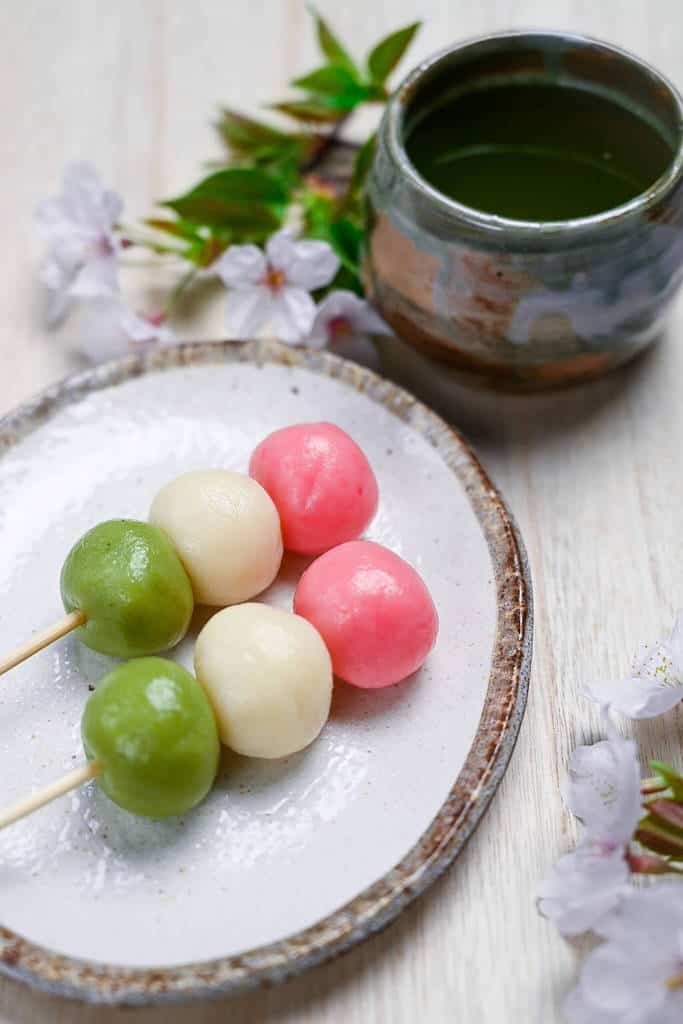
Ingredients
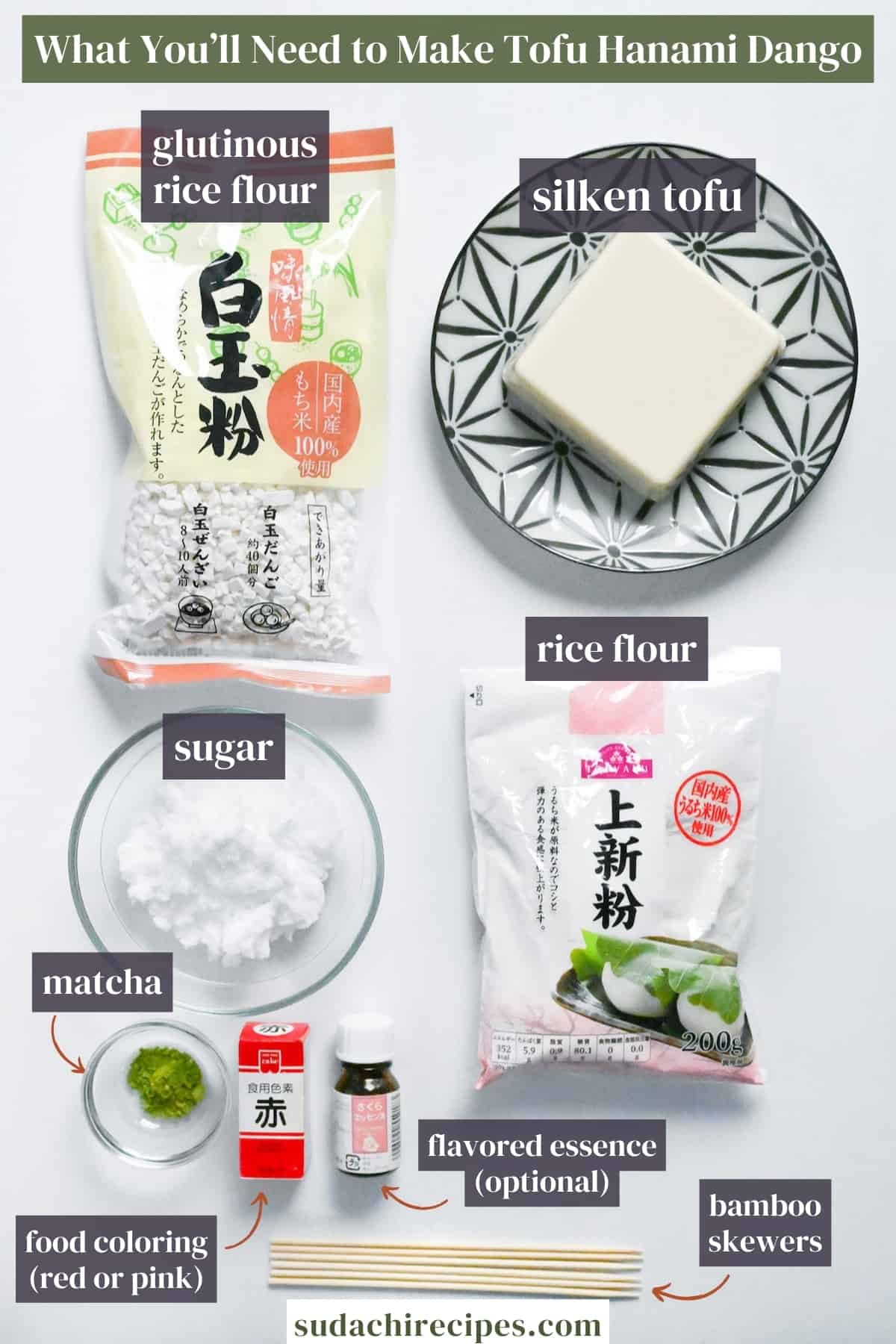
Making hanami dango at home requires a few specific ingredients:
- Glutinous rice flour (shiratamako or mochiko) – Interestingly, glutinous rice flour is not a traditional ingredient used in dango. However, these days, it is often added to yield a softer and stretchier texture. I usually opt for shiratamako but mochiko is cheaper and still works fine too.
- Rice flour (joshinko) – Rice flour is made from regular rice (Japonica rice or “uruchimai”, not mochi rice) and makes the dango firmer and chewier. This is another key ingredient for hanami dango and can’t be substituted.
- Sugar – Required for sweetness, I recommend using white granulated or caster sugar.
- Silken tofu – Using tofu is not traditional at all, however I really enjoy the texture it brings to the dango. It is important to use silken tofu (not firm tofu) due to its high water content. If you prefer not to use tofu, you can substitute water instead. I’ve tried this recipe with both and tofu always wins for me!
- Matcha powder – A little is used for the green-colored dango. It doesn’t make a significant change to the flavor so if you prefer to use green food coloring or something that is also fine. You could also use yomogi (Japanese mugwort) for a more traditional approach.
- Pink food coloring – Used for the pink dango. If you want to avoid food coloring, make them pink by using things like powdered berries or beetroot juice.
- Cherry blossom extract – In the spirit of cherry blossom viewing, I add a small amount of cherry blossom extract. This is also not traditional and purely optional. Feel free to add other flavors of your choice, just make sure to only add a few drops since the flavor should be subtle and not overpowering!
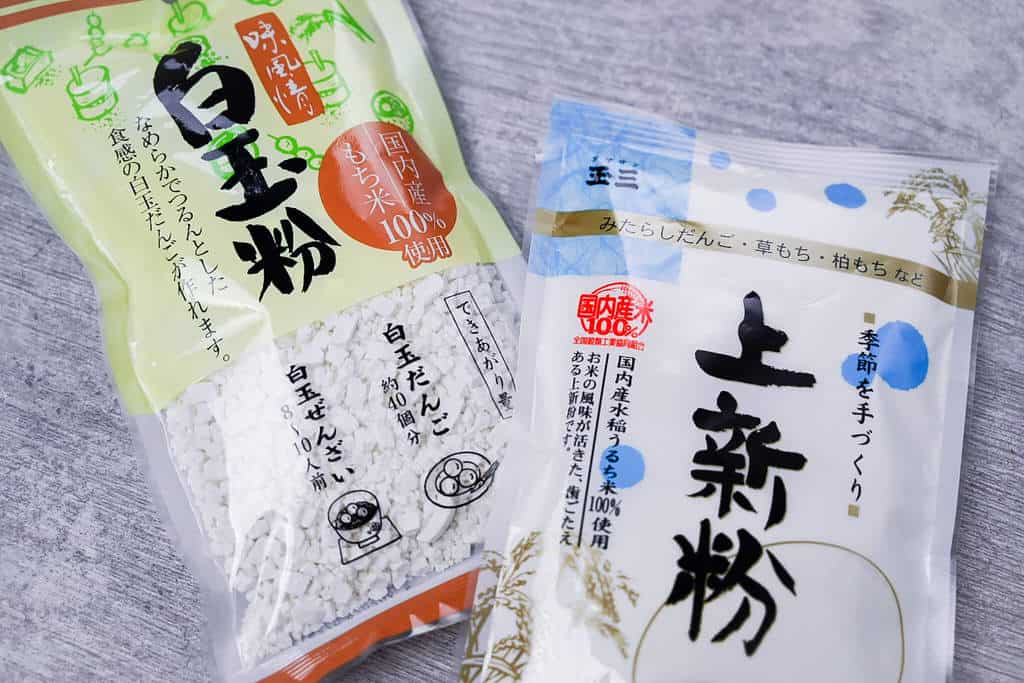
Dangoko (だんご粉) is a mixture of mochiko and joshinko (mochi flour and rice flour). The ratio of mochiko to joshinko varies and results in different textures depending on the brand. If you use mochiko and joshiko separately you will have more control of the texture and can adapt it to suit your preferences. Dangoko usually features instructions on how to make dango using their product on the back, so I recommend following those instructions rather than using it to make my recipe.
Visual Walkthrough & Tips
Here are my step-by-step instructions for how to make Hanami Dango at home. For ingredient quantities and simplified instructions, scroll down for the Printable Recipe Card below.
If you prefer to watch the process in action, check out my YouTube video of this recipe for a complete visual walkthrough!
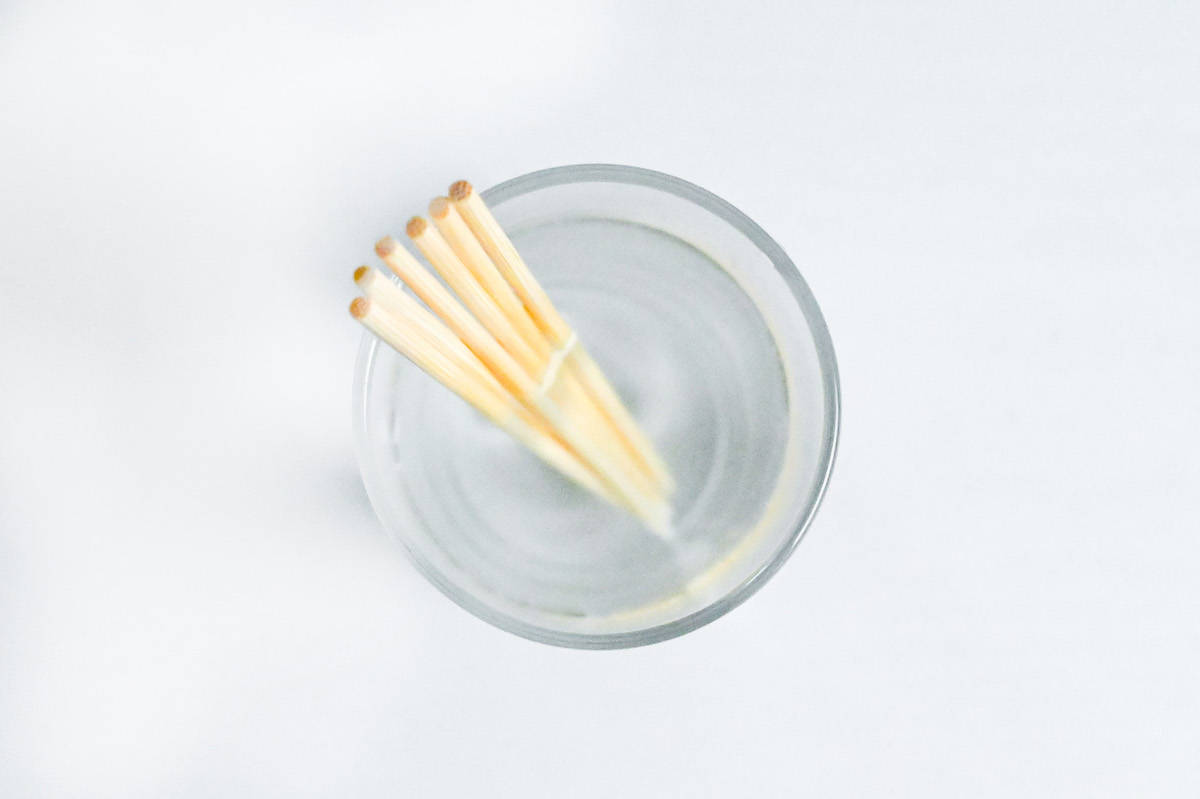
Place the bamboo skewers in a tall glass of water and let them soak while you make the dango. This will make it easier to slide the dango on later.
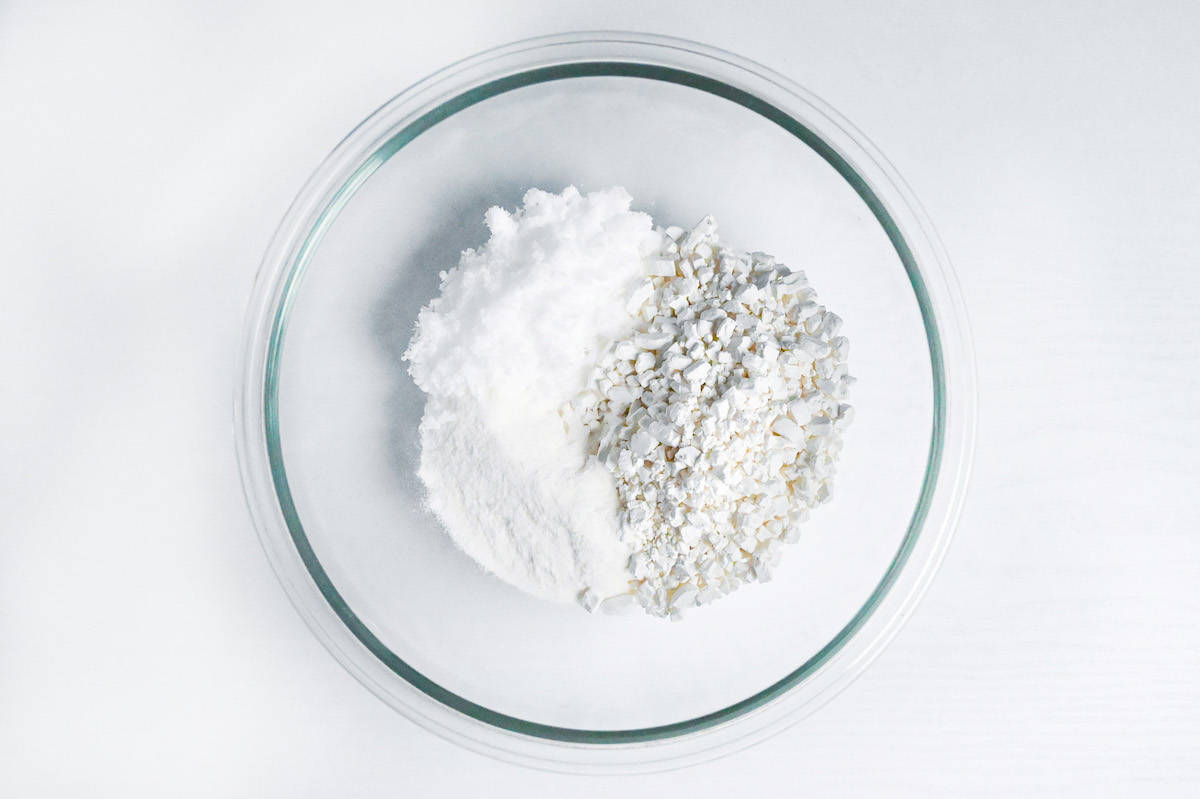
Add the glutinous rice flour (shiratamako or mochiko), rice flour (joshinko), and sugar to a bowl and mix until evenly distributed.

Add the silken tofu one-third at a time and mix thoroughly. Once all of the tofu is mixed in, the mixture should resemble scrambled eggs.
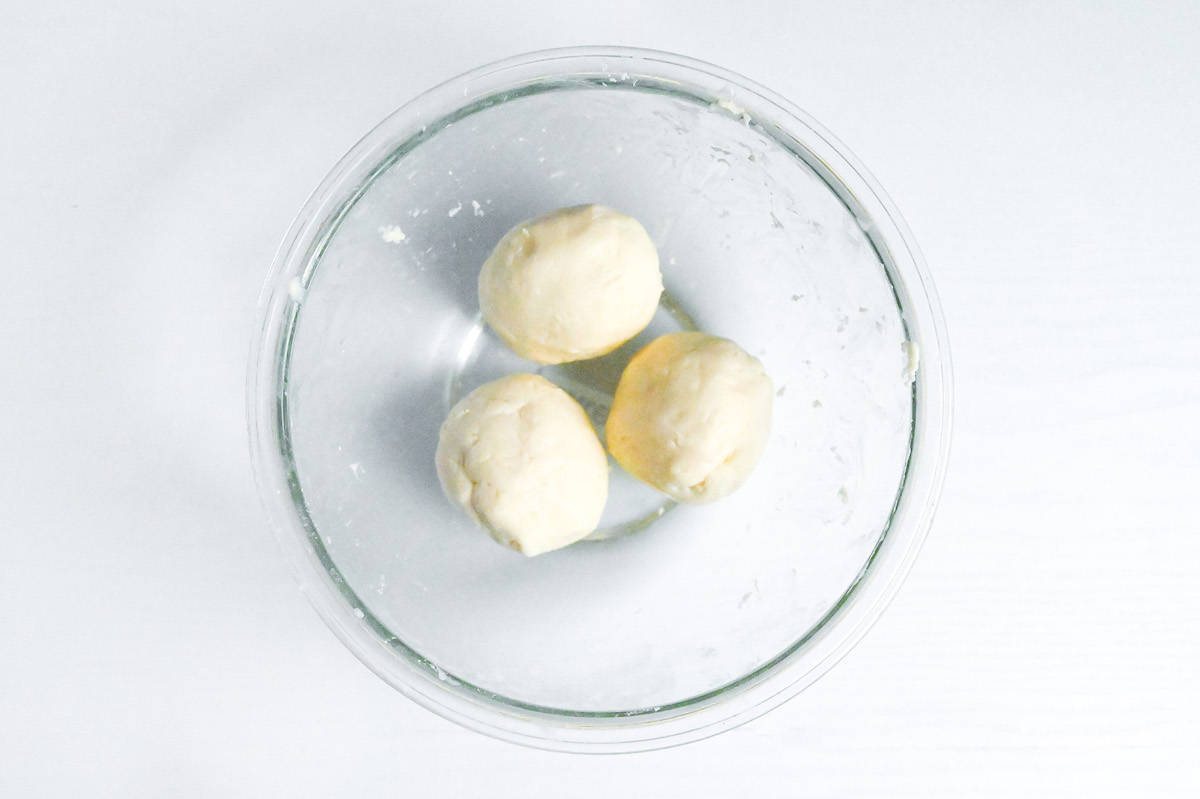
Use your hands to squeeze the crumbs together and form a dough. Gently knead until the texture feels like play dough. If it feels too dry, add a little more tofu or water. (Be careful to add only a little at a time as the dough shouldn’t be too wet.)
In Japanese, we often say that the dough should have the softness of an earlobe!
Once smooth, divide it into three equal pieces. For perfectly uniform dango, use scales to divide it accurately.
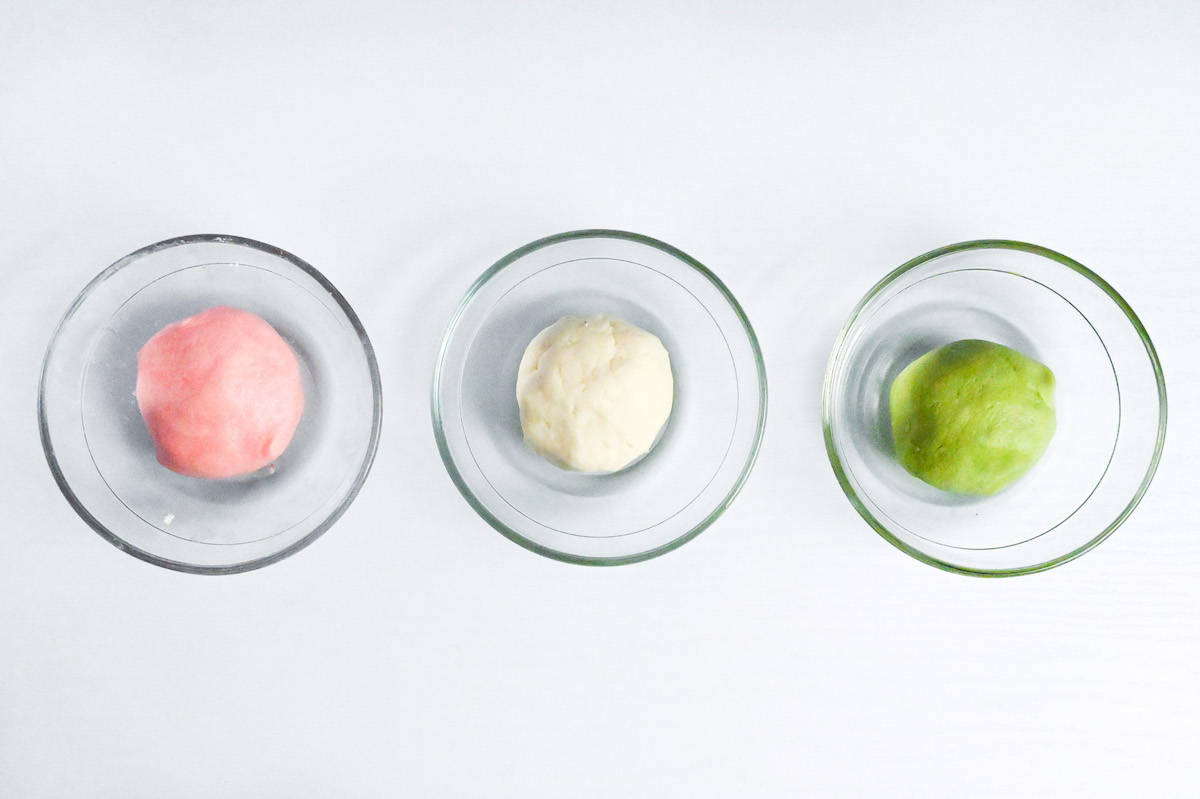
Start boiling a large pot of water. While you wait, place each piece of dango dough in a separate bowl. Leave one white, then add matcha to one bowl and pink food coloring (and cherry blossom extract) to the other. Knead until each dough is evenly colored.
To keep the colors clean and vibrant!

Divide each color into an equal number and roll into balls. I usually aim for 15g per ball.
To save time, I often roll the white balls and add them to the boiling water first. I roll the other colors while I wait for the white ones to cook.
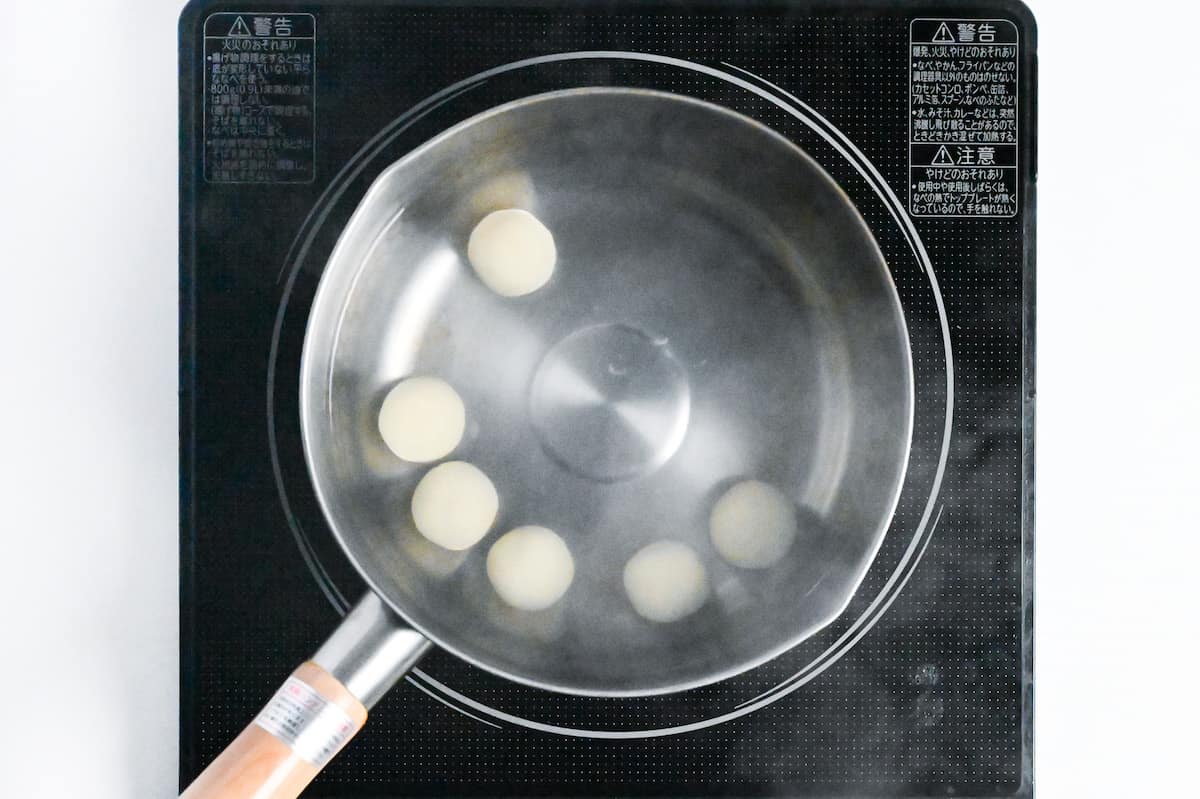
Once the water is boiling, add the white dango and gently mix them to stop them from sticking to the bottom of the pot. Boil until they start to float (about 5-7 minutes) and then set a timer for 2 minutes.
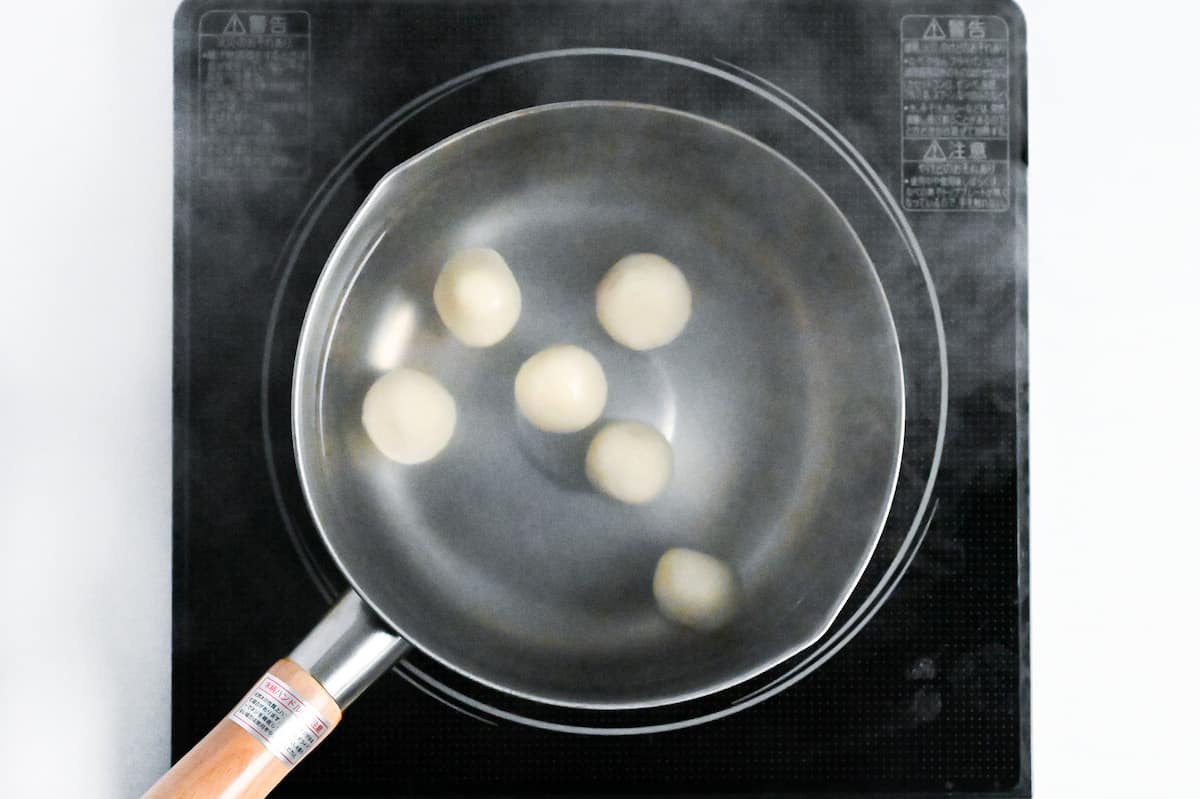
Avoid discolored dango by boiling each color separately! I recommend starting with white first, then pink, and lastly green.
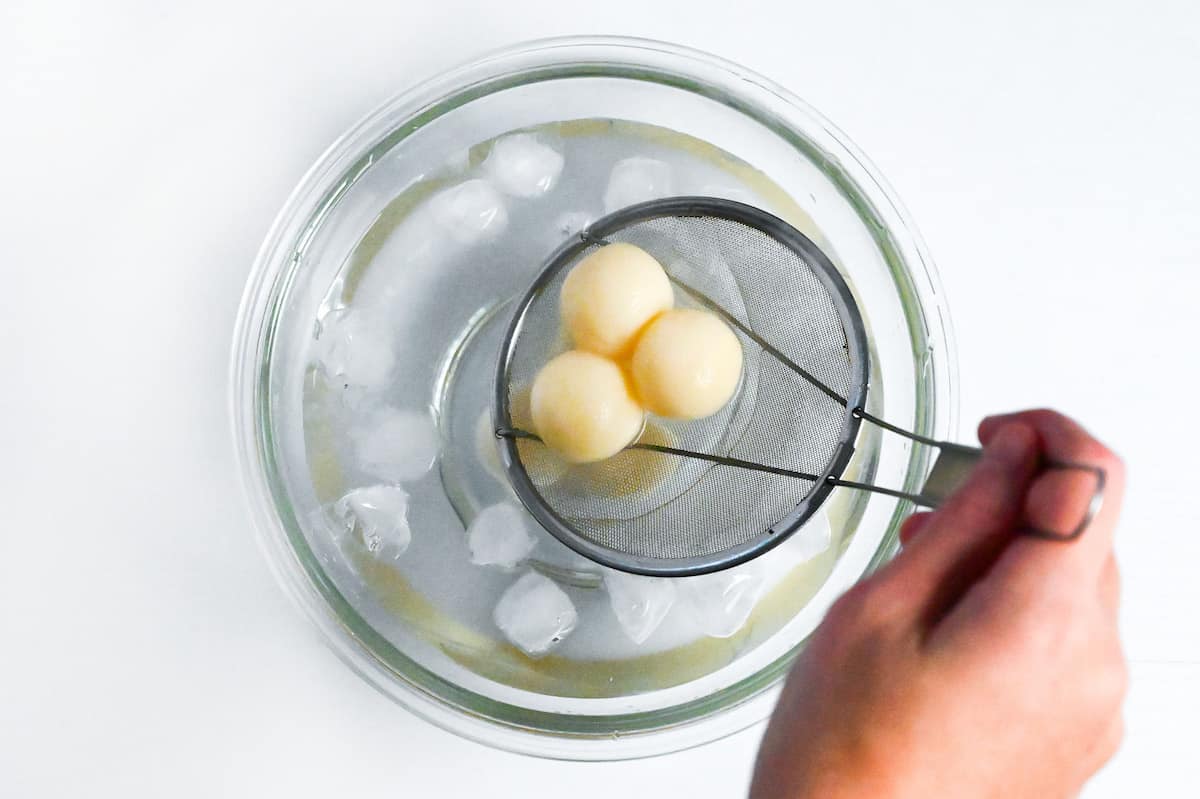
Prepare a bowl of ice water, and once the dango have been floating for 2 minutes, use a slotted spoon to transfer them to the bowl. This will halt the cooking process and stop them from sticking together or becoming misshapen.
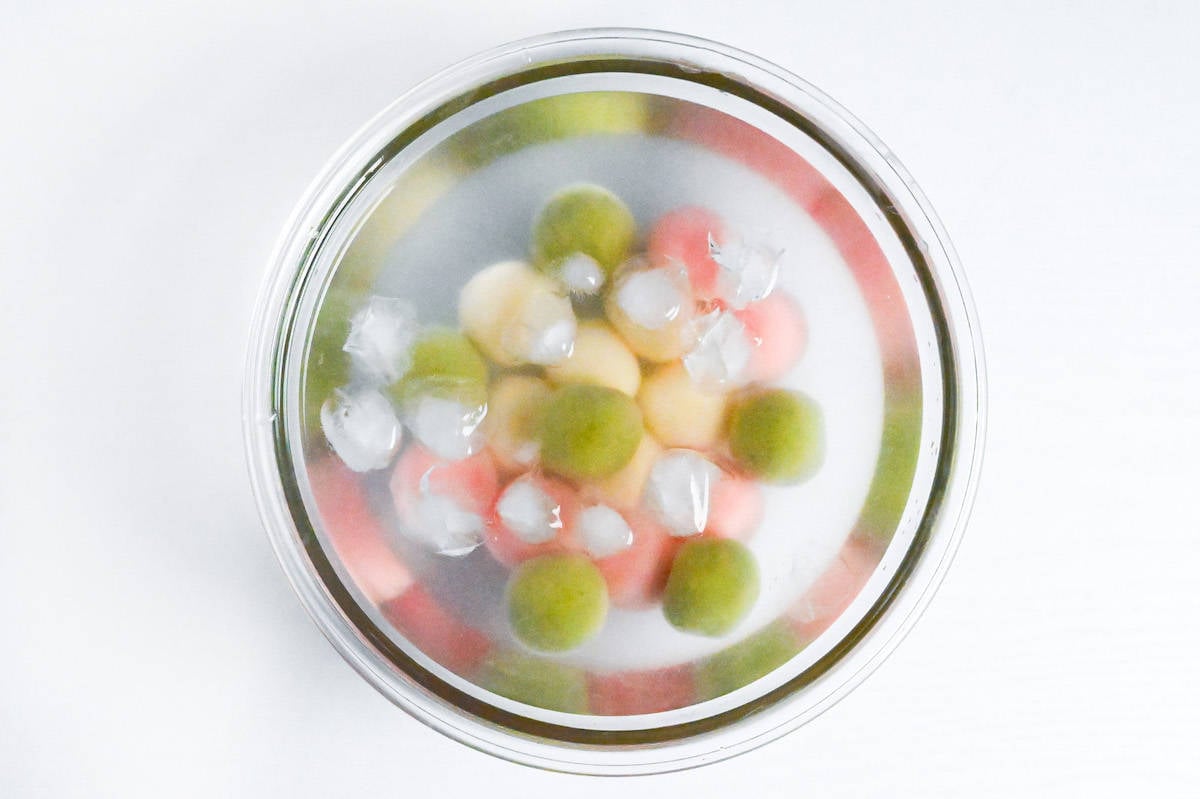
Repeat until all the colors are cooked.
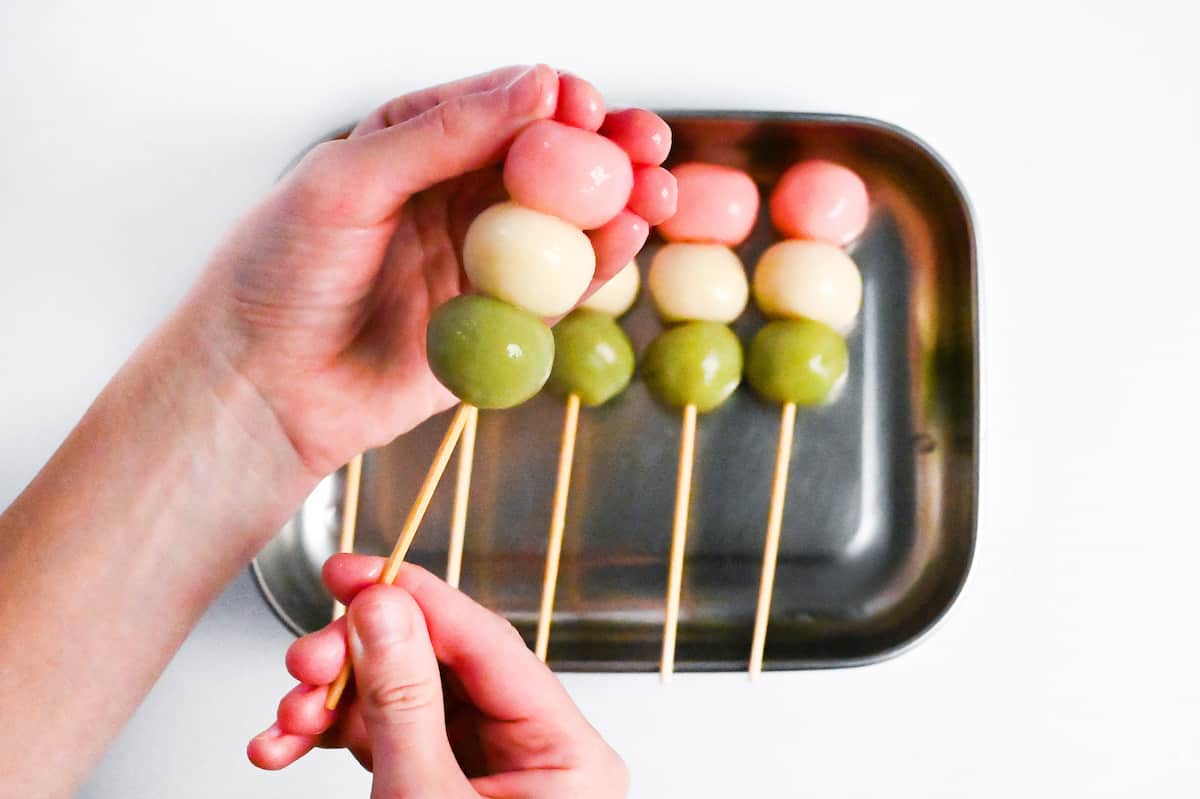
Once the dango have cooled, push them onto the soaked bamboo skewers. Add green first so that it’s at the bottom, then white and finally pink.
Enjoy!
Jump to Full Recipe MeasurementsStorage
Since dango are made from rice flour, they tend to harden after prolonged exposure to air. This makes them unsuitable for refrigeration. They can be kept in an airtight container at room temperature until the end of the day.
After that, I recommend wrapping them with baking paper (to prevent sticking), placing them in a sealable bag and freezing them. They can be frozen for up to 1 month. Thaw at room temperature.
Storage summary
Room temperature – A few hours.
Refrigerated – Not recommended.
Frozen – Up to 1 month.
FAQ
Here are answers to frequently asked questions I have received across all platforms, including here, YouTube, and Pinterest. If you have any questions, feel free to send them to me anytime! It will be a big help for everyone in this community!
The word “hanami” (花見) means “flower viewing” and occurs around late March and early April when the cherry blossoms are in full bloom. Many people gather with friends and family, any enjoy picnics under the beautiful cherry blossoms trees. There are often hanami festivals where food stands are lined up along the trees so you can walk and eat delicious Japanese street food, it’s a great experience!
Hanami Dango was traditionally colored using red Perilla leaves (shiso) and Japanese mugwort (yomogi) that gave them a herby flavor. However, hanami dango these days are plain and do not have a distinct flavor, they essentially taste like sweet rice. You can add powders or extracts to flavor them, but this is not traditional or typical of hanami dango.
Glutinous rice flour (shiratamako or mochiko) and rice flour (joshinko) might be available in well-stocked Asian supermarkets or Japanese specialty food stores (although it is not guaranteed). Since these are dry ingredients, you can find them online. Shiratamako, joshinko, and mochiko on available on Amazon US (affiliate).
I haven’t tried it myself but I’d assume that it would be more difficult to mix in and the texture might be a little dry and not smooth. Since I haven’t tried it, I can’t recommend it.
Sorry, regular flour doesn’t work for dango!
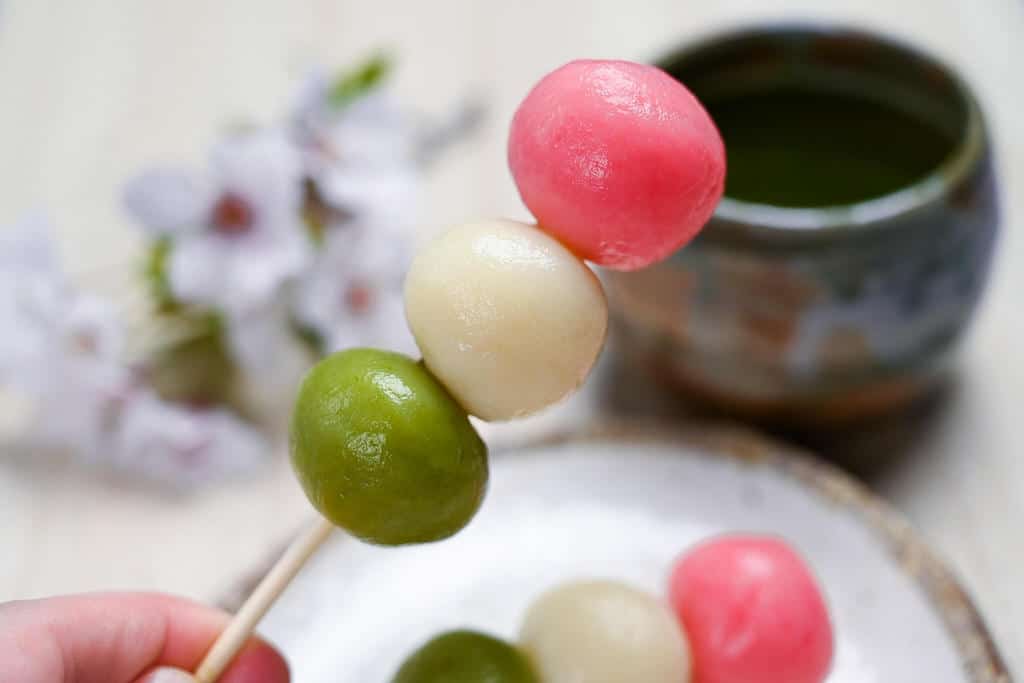
I hope you enjoy this Hanami Dango recipe! If you try it out, I’d really appreciate it if you could spare a moment to let me know what you thought by giving a review and star rating in the comments below. It’s also helpful to share any adjustments you made to the recipe with our other readers. Thank you!
More Wagashi Recipes
- Ichigo Daifuku (Strawberry Mochi)
- Sakura Mochi (Cherry Blossom Rice Cake)
- Mitarashi Dango (Dango with Sauce)
- Tsukimi Dango (Moon Gazing Dango)
Want more inspiration? Explore my Japanese Dessert Roundup Post for a carefully selected collection of tasty recipe ideas to spark your next tea party!
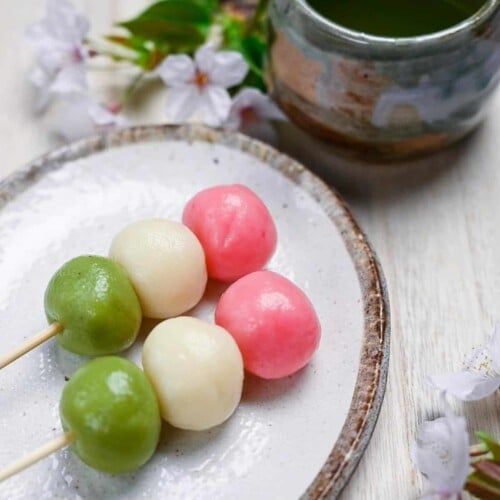
Tofu Hanami Dango (Cherry Blossom Dumplings)
Equipment
Ingredients
- 6 bamboo skewers
- 100 g glutinous rice flour shiratamako or mochiko
- 20 g rice flour (joshinko)
- 45 g granulated sugar
- 120 g silken tofu
- ¼ tsp matcha powder
- 1 drop pink food coloring or a smaller amount of red
- 1 drop cherry blossom extract or flavoring of your choice (optional)
- water for boiling
- 1 bowl ice water
My recommended brands of ingredients and seasonings can be found in my Japanese pantry guide.
Can’t find certain Japanese ingredients? See my substitution guide here.
Instructions
- Soak 6 bamboo skewers in a glass of water.

- Add 100 g glutinous rice flour, 20 g rice flour (joshinko) and 45 g granulated sugar to a bowl and mix until well incorporated.

- Place 120 g silken tofu into the bowl one third at a time, mixing between each addition until the texture resembles scrambled eggs.

- Use your hands to knead the mixture into a smooth dough with a texture similar to play dough. If it's dry or cracks, add a small amount of water or extra tofu (about 1 tsp at a time). Divide it into three equal pieces (use scales for accuracy).

- Place each piece in a separate bowl. Leave one plain, add ¼ tsp matcha powder to one and 1 drop pink food coloring and 1 drop cherry blossom extract to the other.

- Knead until the color/flavor is evenly distributed throughout the dough. (Wash your hands between kneading each color.)

- Start heating a pot of water to a rolling boil. While you wait, divide the dough into 15g pieces. Roll the white pieces into balls first.

- Once the water is boiling, add the white dango balls and boil until they start to float. You can roll the other colors into balls while you wait.

- When they start to float, set a timer for 2 minutes and prepare a bowl of ice-cold water.

- Once the timer is up, transfer the dango to the ice water to stop the cooking process and cool them quickly.

- Repeat with the pink and green dango, cooking each color in separate batches. I recommend pink second and green last. (Top up the pot of water if necessary.)

- Transfer to the ice water and add more ice if needed.

- Once cooled, push the dango onto the skewers. Start with green, then white and lastly pink. Your dango should have green at the bottom and pink at the top.

- Enjoy!
Video
Notes
- If you don’t want to use pink/red food colouring for your dango, you color them with berry powder or 1-2 drops beetroot juice.
- Note: If you use mochiko instead of shiratamako, the texture will be slightly firmer.
- Best eaten the same day.
- If you want to eat it the next day, wrap it in baking parchment and store in an air tight container at room temperature. (Do not store in the fridge as this will make them hard.)
- Hanami Dango can be frozen for up to one month. Thaw at room temperature (about 30 mins to 1 hour) and enjoy!
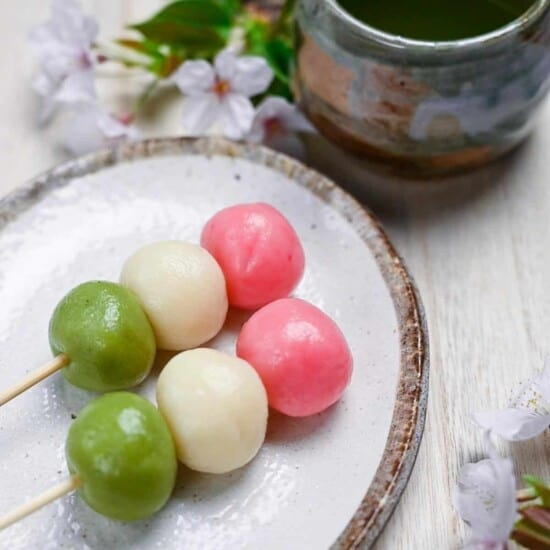




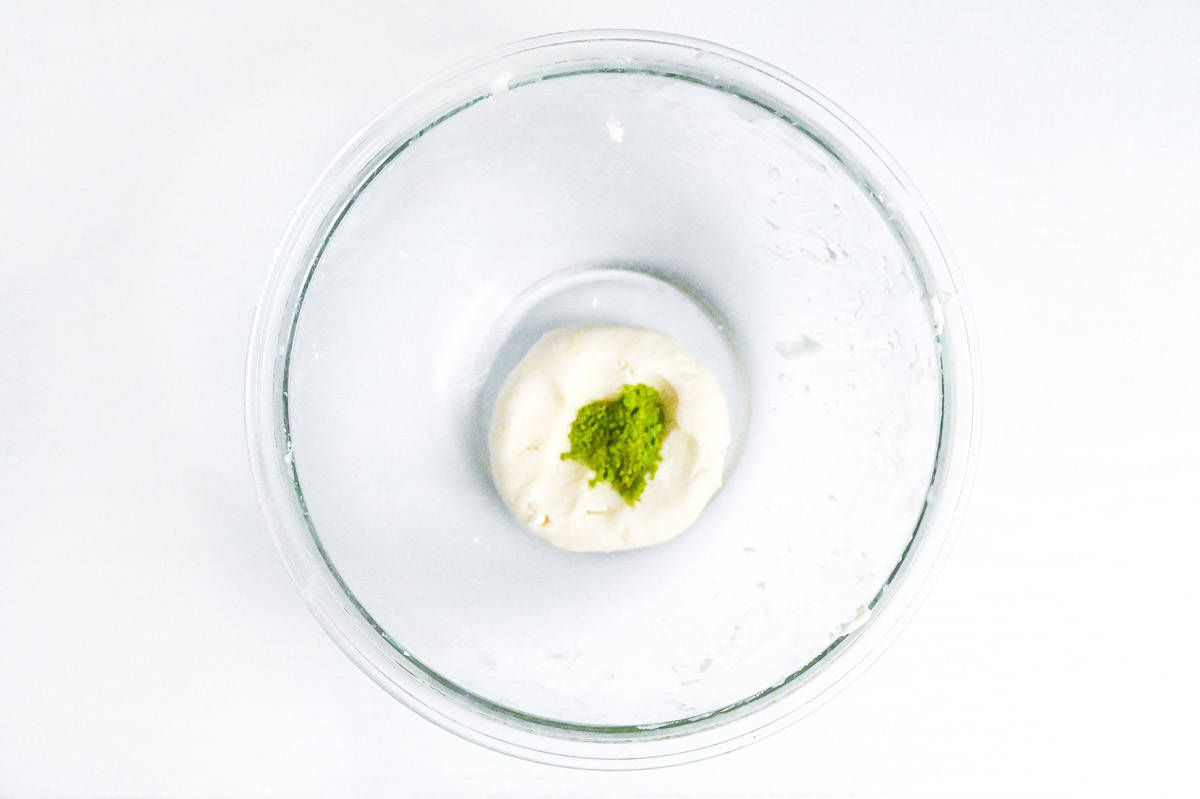
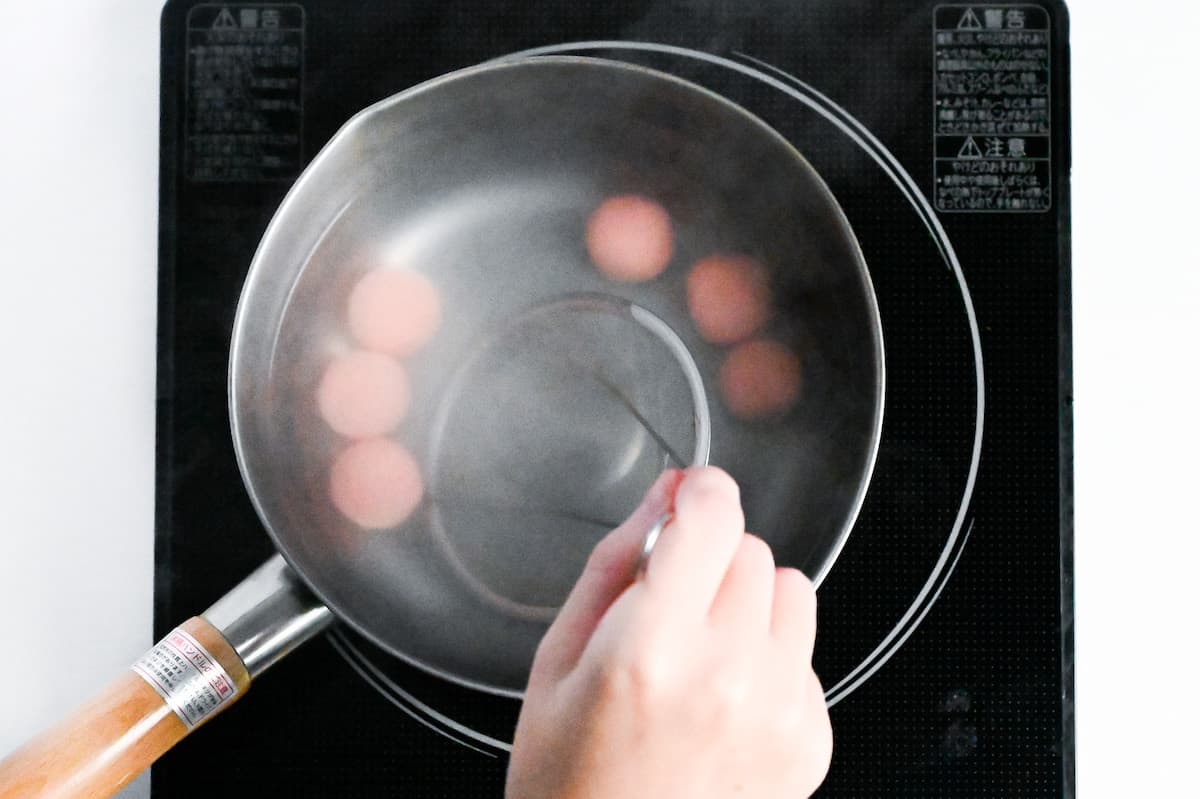
I’ve been making this many times now. Easy to make and delicious dessert. I love it!! Thank you very much for sharing the recipe
Hi Elvira,
That makes me so happy to hear! I’m really glad you’ve been enjoying it — thank you for the kind words!
Yuto